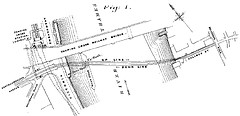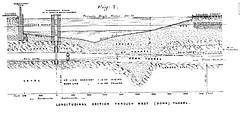I am carrying on my periodic researches into the Whitehall and Waterloo railway – and thanks to an odd letter of reply in a Minutes of the Proceedings of the Institute of Civil Engineering – published in 1902, commenting on a depression in the River Thames, I finally got hold of a copy of the original lecture given by one Arthur Haigh which explains what the reply was – well, replying to.
His speech was about the tunnelling under the Thames for the Baker Street and Waterloo Electric Railway (Bakerloo Line) – the key point being that the riverbed is supposed to be a layer of gravel/mud over London Clay. However right in the line of the Bakerloo line was a huge depression filled with gravel that no one knew about.
The theory is that it was the remains of the tunnelling for the earlier Whitehall and Waterloo railway, which I am looking into. As it happens, the accompanying drawings of the soil samples is not conclusive – but when added to the map of the railway which as it turns out takes a bit of a slanting route under the river, it becomes clear that this depression must be the remains of the earlier railway tunnel. It’s actually quite exciting for me to find this as it does help a lot with the research work.
Anyhow – thanks to the presence of a water soaked gravel in the line of the railway, rather than tunnelling with a normal “shield” through damp clay, they would need to use compressed air at the tunnel face to stop loose gravel and water flooding into the tunnel.
This worked as expected, and gave rise to possibly, the first (and only) fountain/water jet in the River Thames.
As the air pressure was high – and pumped into wet, loose gravel – it naturally escaped out (requiring constant pumping of more air from the river bank). This stream of air blowing out of the tunnel face and up through the gravel gave rise to a fountain of water which clearly marked the location of the tunnel face for people passing by the works along the river bank. The water jet would have moved slowly across the river over the months as the tunnel advanced towards Waterloo.
Indeed, at times – two fountains would erupt, as the pressurised air would escape at two points at the tunnel shield.
Alas, the fountain was not quite of the same scale at the famous fountain at Geneva, Switzerland – but it must have still been quite a sight for London to see the “modern” railway causing such a commotion in the river.
—
So – the remains of the earlier pneumatic railway foundations caused quite a considerable amount of delay and cost to the later Bakerloo line railway – opps! It would be interesting to see what the cost implications of tunnelling through an unexpected gravel depression were – as there is a probability that they exceeded the entire cost of the earlier railway. Maybe an additional bit to look into.
I have uploaded a few line drawing maps that show how the Bakerloo line runs at an angle under the Thames. As the Whitehall railway went in a straight line across, you can probably work out how the depression in the second image affected things.
You may also note from the images that the two tunnels are displaced – on the Whitehall side they ran side by side, but on the approach to Waterloo, they twist to run one above the other. This reduces the width of the planning controls for the tunnels so that it could pass under a street and not under houses – which would have required compensation to be paid to the landlords. That happens a lot under London.
As a final aside – it was also noted that it was the London Hydraulic Company which powered the machinery used during the tunnelling under the Thames. This was a network of high pressure water pipes running under London as an early “power supply” before Electricity was common-place, and was related to my earlier researches into the Tower Subway tunnel some years ago. Nice to see an “old friend” turn up in the archives again.
Click on the images for larger versions at Flickr
| Plan of Bakerloo Line under the Thames | Side profile of River Thames |
 |
 |







[…] How the Bakerloo Line created a Water Jet in the Thames I am carrying on my periodic researches into the Whitehall and Waterloo railway – and thanks to an odd letter of reply in a Minutes of the Proceedings of the Institute of Civil Engineering – published in 1902, commenting on a depression in the River Thames, I finally got hold of a copy of the original lecture given by one Arthur Haigh which explains what the reply was – well, replying to. His speech was about the tunnelling under the Thames for the Baker Street and Waterloo Electric Posted in Civil-Engineering | Trackback | del.icio.us | Top Of Page […]